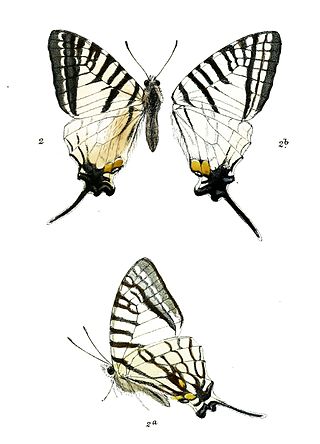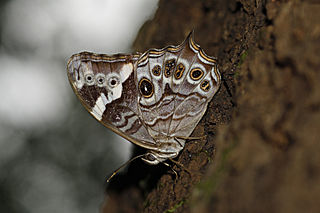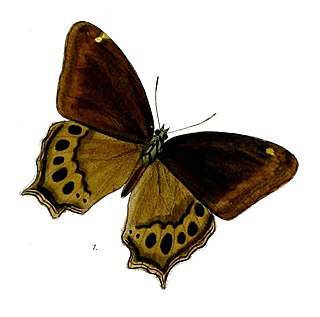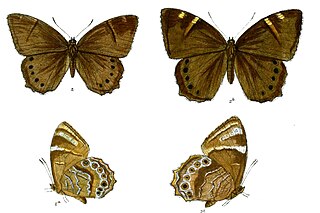
Graphium eurous, the sixbar swordtail, is a swallowtail butterfly belonging to the genus Graphium, also known as the swordtails.

Byasa latreillei, the rose windmill, is a butterfly from the windmills genus (Byasa), found in various parts of Asia, comprising tailed black swallowtail butterflies with white spots and red submarginal crescents.

Charaxes solon, the black rajah, is a butterfly species found in tropical Asia. It belongs to the Charaxinae in the brush-footed butterfly family (Nymphalidae).

Lethe rohria, the common treebrown, is a species of satyrine butterfly found in Asia.

Lethe confusa, the banded treebrown, is a species of butterfly belonging to the satyr family that is found mainly in Southeast Asia and in parts of South Asia.

Lethe visrava, the white-edged woodbrown, is a species of satyrine butterfly found in Asia, where it is known from Sikkim to Bhutan, Assam and Burma.

Lethe sura, the lilacfork, is a species of nymphalid butterfly found along the eastern Himalayas from Sikkim in India to northern Burma. It is also found in Southeast Asia

Neope yama, the dusky labyrinth, is a species of satyrine butterfly found in Asia. In the Himalayas it is common from the eastern Himalayas to eastern Nepal and less common from western Nepal to Himachal Pradesh.

Vamuna remelana is a species of moth of the subfamily Arctiinae first described by Frederic Moore in 1866. It is found in India, Peninsular Malaysia, Sumatra, Borneo and Java.

Lethe kansa, the bamboo forester, is a species of Satyrinae butterfly found in the Indomalayan realm

Lethe siderea , the scarce woodbrown, is a species of Satyrinae butterfly found in the Indomalayan realm. The species was first described by George Frederick Leycester Marshall in 1880. It is legally protected in India under Schedule II of the Wild Life (Protection) Act, 1972.

Lethe sidonis, the common woodbrown, is a species of Satyrinae butterfly found in the Indomalayan realm.

Lethe nicetella, the small woodbrown, is a species of Satyrinae butterfly found in the Indomalayan realm.

Lethe goalpara , the large goldenfork, is a species of Satyrinae butterfly found in the Indomalayan realm.

Lethe ramadeva, the single silverstripe, is a species of Satyrinae butterfly found in the Indomalayan realm.

Lethe tristigmata, the spotted mystic, is a species of Satyrinae butterfly found in the Indomalayan realm. In 2015, it was also recorded from Neora Valley National Park in West Bengal, India.

Lethe dura, the scarce lilacfork, is a species of Satyrinae butterfly found in the Indomalayan realm.


















